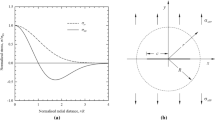Abstract
The influence of the thickness of a cracked plate, made of Polycarbonate of Bisphenol A, on the plastic zones developed at the crack tip was studied. The three-dimensional character of yielding at the vicinity of the crack tip is revealed. The study of the thickness variation in the plastic zones is made by applying the shadow-moiré method. It has been derived that the thickness variation in the plastic zones is discontinuous with successive dimples of different thickness. The influence of the overall thickness of the specimen on the size and length of the plastic zone was studied for different crack lengths. Irwin's theory for small yielding, as well as the simple and modified Dugdale-Barenblatt models, were applied for the study of plastic zones. By comparing the plastic-zone lengths in relation to their shape, with those given by the above theories, it may be concluded that, for small loads where the applied stress σ is not exceeding 0.40 of the yield stress\(\sigma _o \) in tension and small values of the ratio of crack lengtha to plate thicknesst, (a/t<4) a state of plane strain dominates at the vicinity of the crack tip, while, by increasing the load and ratioa/t, the plastic zones approach in shape and size those given by the modified Dugdale-Barenblatt model.
Similar content being viewed by others
References
Irwin, G. R., “Plastic Zone Near a Crack and Fracture Toughness,” Proc. Sagamore Research Conf. on Ordnance Materials (1960).
Dugdale, D. S., “Yielding of Steel Sheets Containing Slits,”J. Mech. Phys. Solids,8,100–104 (1960).
Hahn, G. T. andRosenfield, A. R., “Local Yielding and Extension of a Crack Under Plane Stress,”Acta Metall.,13,293–306 (1965).
Rice, J. R., “Mathematical Analysis in the Mechanics of Fracture,”Fracture, ed. by H. Liebowitz, Acad. Press, New York,2,191–311 (1968).
Smith, E., “The Spread of Plasticity from Stress Concentration,”Proc. Roy. Soc., Series A,285,46–57 (1965).
Bilby, B. A., Cottrell, A. H. andSwiden, K. H., “The Spread of Plastic Yield from a Notch,”Proc. Roy. Soc., Series A,272,304–314 (1963).
Ault, R. T., andSpretnak, J. W., “Initial Yielding and Fracture in Notched Sheet Molybdenum,”Int. J. Mech. Sc.,7,87–102 (1965).
Oppel, G. V. andHill, P. W., “Strain Measurements at the Root of Cracks and Notches,”Experimental Mechanics,4 (7),206–211 (July 1964).
Bateman, D. A., Bradshaw, F. J. and Rooke, D. P., “Some Observations on Surface Deformation Round Cracks in Stressed Sheets,” Royal Aircraft Establishment Technical Note No. CPM. 63 (March 1964).
Rosenfield, A. R., Dai, P. K. andHahn, G. T., “Crack Extension and Propagation Under Plane Stress,”Proc. 1st Int. Conf. on Fracture,I,223–258,Sendai, Japan (1966).
Theocaris, P. S., “Stress Intensity Factors in Yielding Materials by the Method of Caustics,”Int. J. Fract. Mech.,9,321–334 (1973).
Theocaris, P. S., andGdoutos, E., “Experimental Study of the Modified Dugdale-Barenblatt Model Adapted to Various Fracture Configurations in Metals,”Int. J. Fract. Mech., 10, 549–564 (1974).
Theocaris, P. S., andMarketos, E., “The Elastic-Plastic Strain and Stress Distribution in Notched Plates under Conditions of Plane-Stress,”J. Mech. Phys. Solids,11,411–428 (1963).
Rivlin, R. S., andThomas, A. G., “Rupture of Rubber-I. Characteristic Energy for Tearing,”J. Polym. Sc.,10,291–318 (1953).
Williams, M. L., “The Fracture of a Viscoelastic Materials,”Fracture of Solids, ed. by D. C. Drucker andJ. J. Gilman, Wiley Interscience, New York, 157–188 (1963).
Berry, J. P., “Fracture of Polymeric Glasses,”Fracture, ed. by H. Liebowitz, Academic Press, New York,7,37–92 (1972).
Kambour, R. F., “Mechanism of Fracture in Glassy Polymers,”J. Polym. Sc. A2,4,17–24,349–363 (1966).
Ferguson, R. J., Marshall, G. P., and Williams, J. G., “The Application of the J Concept to the Fracture of Tough Plastics,” 3rd Int. Cong. on Fracture, Munchen, Preprint VII, VI-514 (1973).
Brinson, H. F., “The Ductile Fracture of Polycarbonate,”Experimental Mechanics,10 (2),72–77 (Feb. 1970).
Smith, D. G. andSmith, C. W., “Photoelastic Determination of Mixed Mode Stress Intensity Factors,”Eng. Fract. Mech.,4,357–366 (1972).
Dally, J. W., “Classical and Advanced Methods of Photoelasticity,” Proc. IUTAM Symp. on Photoelasticity, Brussels (Sept. 1973).
Theocaris, P. S., “A Critical Review on the Use of Polymers in Photoplasticity,” Proc. IUTAM Symp. on Photoelasticity, Brussels (Sept. 1973).
Theocaris, P. S., “Dependence of the Stress-Optical Coefficients on the Mechanical and Optical Properties of Polymers,”J. Strain Anal.,8 (4),267–276 (1973).
Yannas, I. V., andDoyle, M. J., “Comparison of Optical and Mechanical Limits of Linear Relaxation Behavior in Glassy Polycarbonate,”J. Pol. Sc., A2,10,159–170 (1972).
Theocaris, P. S., “Moiré Fringes in Strain Analysis,”Pergamon Press, London, 219–241, 41–55 (1969).
Paris, P. C., and Sih, G. C., “Stress Analysis of Cracks,” Fracture Toughness Testing and Its Applications, ASTM Sp. Tech. Publ. No. 381, 30–81 (1965).
Theocaris, P. S., “Local Yielding Around a Crack Tip in Plexiglas,”J. Appl. Mech.,37,409–415 (1970).
Argon, A. S., “Plastic Deformation in Glassy Polymers,” Relationships Between Structure and Mechanical Behavior in Polymeric Solids,” ed. by E. Baer and V. Radcliffe, A.S.M. Publ. (1974).
Creager, M., andParis, P. C., “Elastic Field Equations for Blunt Cracks with Reference to Stress Corrosion Cracking,”Int. J. Fract. Mech.,3,247–251 (1967).
Brinson, H. F., “An Interpretation of Inelastic Birefringence,”Experimental Mechanics,11 (10),467–471 (Oct. 1971).
Author information
Authors and Affiliations
Rights and permissions
About this article
Cite this article
Theocaris, P.S., Gdoutos, E.E. The size of plastic zones in cracked plates made of polycarbonate. Experimental Mechanics 15, 169–176 (1975). https://doi.org/10.1007/BF02319142
Received:
Revised:
Issue Date:
DOI: https://doi.org/10.1007/BF02319142




